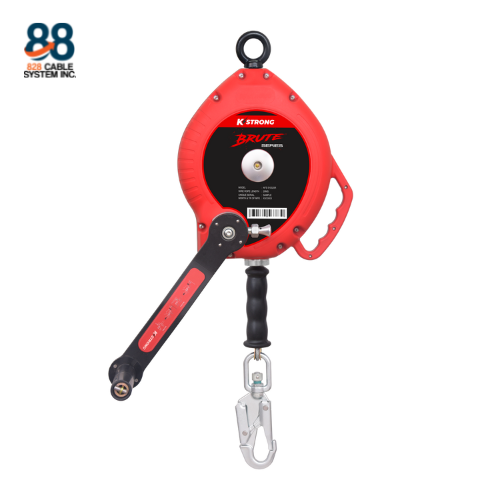
In the realm of workplace safety, choosing the right fall protection equipment is crucial to safeguarding employees from potentially life-threatening accidents. Among the many options available, self-retracting lanyards (SRLs) and traditional lanyards are two popular choices. Both serve the purpose of preventing falls, but they do so in different ways. This blog explores the key differences between self-retracting lanyards and traditional lanyards to help you determine which is better suited for your specific needs.
What Are Self-Retracting Lanyards?
Self-retracting lanyards (SRLs), also known as self-retracting lifelines, are advanced fall protection devices designed to keep users secure while allowing freedom of movement. These lanyards feature an automatic retraction mechanism that maintains constant tautness, similar to a car seatbelt. This design enables the lanyard to extend and retract smoothly as the user moves. In the event of a fall or sudden tug, an internal braking system activates to prevent further descent, minimizing the impact and ensuring safety.
What Are Traditional Lanyards?
Traditional lanyards, on the other hand, are more straightforward fall protection devices. They consist of a static length of webbing or rope with adjustable components. Unlike SRLs, traditional lanyards require manual adjustment to fit the user’s needs and do not feature automatic retraction. These lanyards rely on shock-absorbing materials to reduce the impact of a fall, and they typically have a fixed length, which can limit mobility.
Key Differences Between Self-Retracting Lanyards and Traditional Lanyards
Mechanism of Action: Self-retracting lanyard automatically adjust their length, offering constant tension and a braking system that engages in the event of a fall. Traditional lanyards require manual adjustments and have a fixed length that can result in slack.
Safety Features: SRLs provide enhanced safety with their braking systems that arrest falls more quickly and effectively. Traditional lanyards absorb impact through their design but may allow for a longer fall distance.
Comfort and Mobility: SRLs offer greater comfort and mobility, as the automatic retraction keeps the lanyard taut and prevents it from getting in the way. Traditional lanyards can restrict movement due to their fixed length and manual adjustment requirements.
Maintenance and Durability: SRLs generally require less maintenance due to their self-contained system, while traditional lanyards might need more frequent checks and adjustments.
Advantages of Self-Retracting Lanyards
Enhanced Safety: The automatic braking system of SRLs reduces fall distances and spreads the impact force over a shorter distance, which significantly improves user safety.
Increased Mobility: SRLs allow users to move more freely within their work area since the lanyard retracts automatically as they move.
Low Maintenance: With fewer manual adjustments and components, SRLs are generally easier to maintain and inspect compared to traditional lanyards.
Advantages of Traditional Lanyards
Cost-Effectiveness: Traditional lanyards usually have a lower upfront cost compared to SRLs, making them a budget-friendly option.
Simplicity: Their basic design and manual operation make traditional lanyards easy to use and understand without the need for complex mechanisms.
Ease of Use: Traditional lanyards can be simpler to handle and deploy, as they do not have moving parts or automatic systems.
Choosing the Right Lanyard for Your Needs
Selecting the appropriate lanyard involves considering factors such as the type of work, environmental conditions, and budget constraints. For tasks that require extensive movement or work at varying heights, SRLs may provide superior safety and convenience. In contrast, traditional lanyards might be suitable for less dynamic environments or where cost is a significant factor. Ensure that whichever lanyard you choose meets relevant safety standards and regulations.
Takeaway
Both self-retracting lanyards and traditional lanyards have their unique advantages and limitations. Self-retracting lanyards offer enhanced safety features and greater mobility, making them ideal for dynamic work environments. Traditional lanyards, with their lower cost and simplicity, can be a practical choice for more static tasks. Ultimately, the best choice depends on your specific needs and circumstances. Evaluate your fall protection requirements carefully to ensure you select the most suitable lanyard for your situation.



